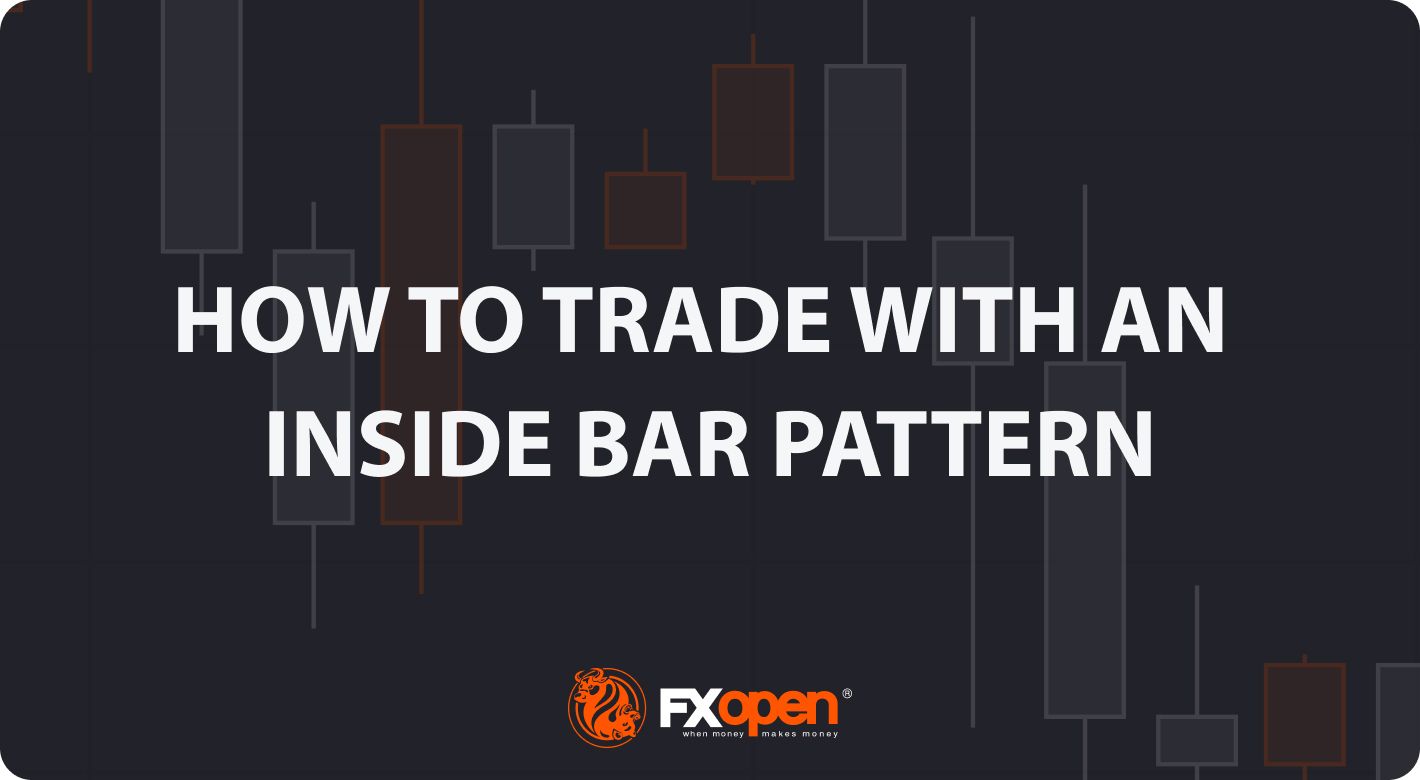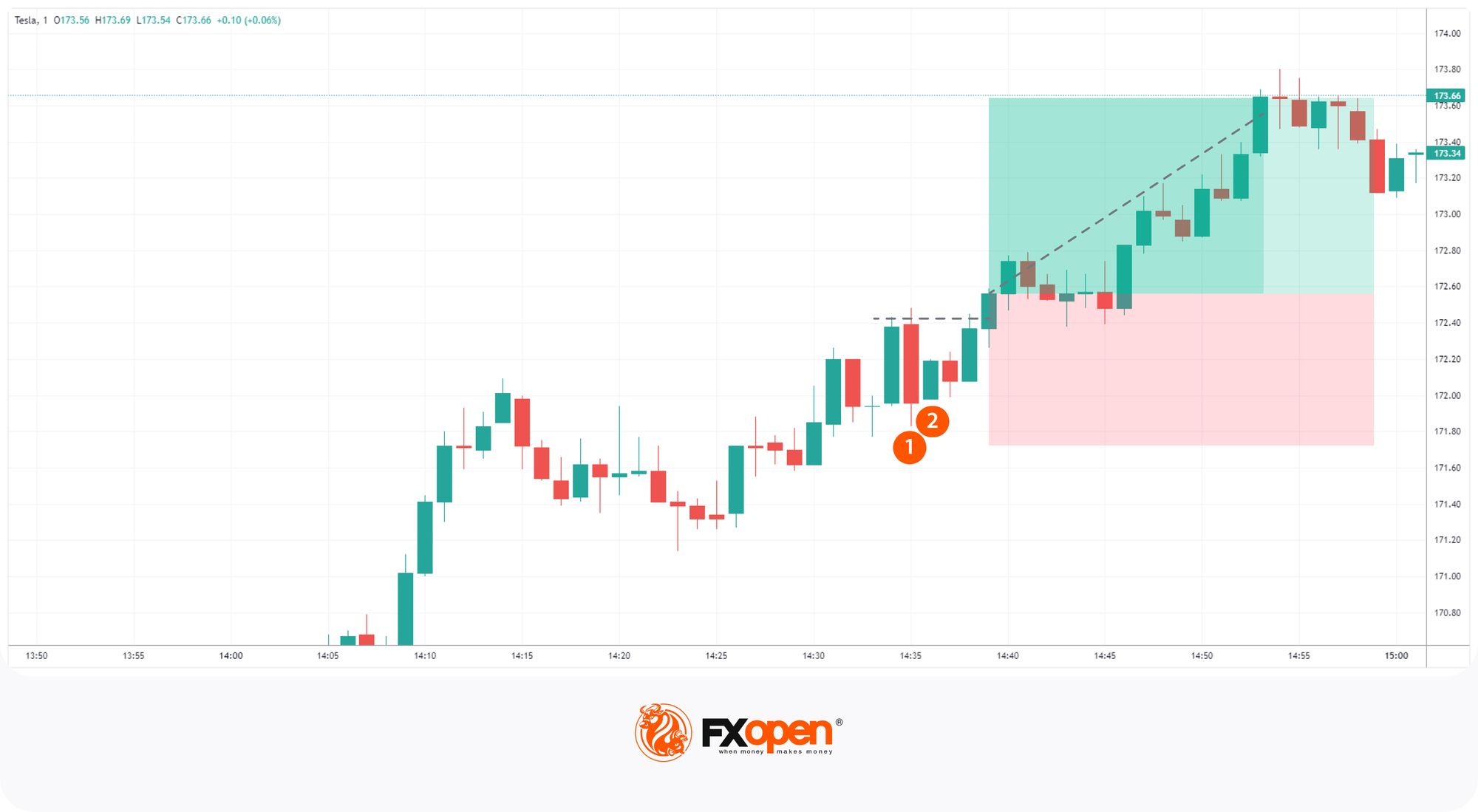FXOpen

The inside bar pattern is characterised by two consecutive candlesticks that often suggest a period of consolidation or indecision in the market. Traders and analysts can find value in identifying the setup as it can provide insights into potential future price movements. In this article, we will explore different examples of this formation on price charts and discuss how to interpret their signals for trading purposes.
What Is an Inside Bar Candle Pattern?
An inside bar is a two-candlestick formation that occurs when a candlestick's high and low range is contained within the high and low range of the preceding candle. In other words, the entire price action of one candle is confined within the previous candlestick's price range.
The setup signifies a period of consolidation or indecision in the market; however, it doesn’t identify a trend reversal. The price may continue moving in the prevailing trend or turn around. Also, the pattern may appear both in an uptrend and in a downtrend. It indicates that the trading range of the current candle is narrower than the range of the previous candlestick. This contraction in price volatility suggests a temporary equilibrium between buyers and sellers.
The inside bar can be observed across different financial instruments such as stocks, cryptocurrencies*, ETFs, indices, and forex currency pairs and can be traded using contracts for difference (CFDs) provided by FXOpen.
Identifying the Inside Bar on Trading Charts
To identify this formation on trading charts, traders follow these steps:
- Look for two candlesticks: Start by identifying a candlestick with a defined high and low range and check a subsequent candlestick.
- Compare the high and low range: Check if the high and low range of the subsequent candle is entirely contained within the high and low range of the preceding candlestick. The entire price action of the following candles should be within the boundaries of the last candlestick.
- Confirmation: Once identifying that the subsequent candle meets the criteria, traders can confirm it as an inside bar.
Inside Bar vs Outside Bar
The inside candle pattern occurs when the high and low of a candle are contained within the range of the preceding candlestick, indicating consolidation or indecision in the market. It suggests a potential reversal or continuation of the current trend. On the other hand, an outside bar, or engulfing pattern, happens when the high and low of a candlestick completely engulf the previous candle, signalling a potential reversal. A bearish engulfing indicates a bearish reversal, while a bullish engulfing suggests a bullish reversal. Both are widely used by traders for technical analysis and identifying potential trading opportunities.
Traders can analyse outside and inside bars on forex, stocks, and other markets for free using the FXOpen TickTrader platform.
How to Trade the Inside Bar Pattern
Trading with the inside bar candlestick pattern involves using it as a signal for potential breakouts or continuation of the prevailing trend. Here are the steps traders usually follow when trading with the pattern:
- Determine the direction of the preceding trend: Traders assess the overall trend leading up to the formation. If it's an uptrend, the preceding candles should be mostly bullish. If it's a downtrend, the prior candles should be mostly bearish.
- Wait for a breakout: The formation indicates consolidation and potential price compression. Traders often wait for a breakout from the setup's range to initiate a trade. A breakout above the high of the formation suggests a bullish signal, while a breakout below the low indicates a bearish signal.
- Set your entry: Once the breakout occurs, traders may set the entry order slightly above the high of the bullish breakout or slightly below the low of the bearish breakout.
- Consider additional confirmation: To increase the probability of a successful trade, traders may look for additional confirmation indicators such as volume analysis, trendlines, or other technical indicators to support your trade decision. An increasing volume at the breakout or the breakout from a trendline may provide additional confluence.
- Manage your trade: As the trade progresses, traders monitor price movements and may want to adjust your stop-loss level to protect profits or limit losses.
- Take profits: Traders may decide on your profit-taking strategy, whether it's a predetermined target, a trailing stop, or monitoring key levels of support and resistance.
Live Market Example
Below, you can see an inside bar stock pattern on the Tesla chart. It contains a bullish inside bar. Following the inside bar trading strategy, the trader waits for the breakout above the setup marked by a horizontal line. The stop loss is set below the low of the formation, and the take profit is at the next resistance.

Final Thoughts
While the setup can be a useful tool for identifying potential breakout or continuation opportunities, it's important for traders not to rely solely on this pattern for their trading decisions. To enhance their analysis, traders combine the formation with other technical indicators and utilise effective risk management strategies to manage potential losses.
It's crucial to exercise caution and be mindful of false signals that can occur. Traders try to adapt their trading strategies accordingly to improve their chances of success. To develop your own trading strategy with this pattern, you can open an FXOpen account.
FAQ
Is an inside bar bullish or bearish?
It does not inherently indicate a bullish or bearish bias. It simply represents a period of consolidation or indecision in the market. So, the formation occurring within an uptrend can be bullish and signal a trend continuation or bearish and signal a trend reversal.
What does an inside bar bullish mean?
The meaning of an inside candle that is bullish refers to an inside bar, after which the price moves upwards. When this pattern forms during an uptrend, it suggests a temporary pause or consolidation in price before the uptrend potentially resumes. When it is formed in a downtrend, it signals a trend reversal.
How do you use the inside bar strategy?
To use the strategy, traders wait for the inside bar to form and then look for a breakout above the high of the formation to enter a long position or below the low to enter a short trade. A stop-loss order is typically placed below the low of the pattern in a long trade and above the high of the pattern in a short trade. Profit targets can be determined based on the trader's trading plan, technical indicators, or key support and resistance levels.
* At FXOpen UK and FXOpen AU, Cryptocurrency CFDs are only available for trading by those clients categorised as Professional clients under FCA Rules and Professional clients under ASIC Rules, respectively. They are not available for trading by Retail clients.
This article represents the opinion of the Companies operating under the FXOpen brand only. It is not to be construed as an offer, solicitation, or recommendation with respect to products and services provided by the Companies operating under the FXOpen brand, nor is it to be considered financial advice.
Stay ahead of the market!
Subscribe now to our mailing list and receive the latest market news and insights delivered directly to your inbox.








